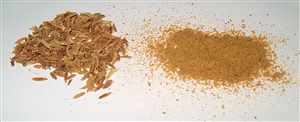Cumin (Cuminum cyminum)
Main Facts about Cumin

Cumin is the dried seed of the herb Cuminum cyminum, a member of the parsley family. The plant is small, growing on average to about 16 inches, with umbel-like flowers and thin, feathery leaves. It is an annual herbaceous plant which is harvested by hand. Cumin seeds have eight ridges with oil canals. They resemble caraway seeds, but are lighter in color and unlike caraway, have tiny bristles barely visible to the naked eye.
Native to Asia or Egypt (the seeds have been found in the Old Kingdom pyramids), Cumin has been cultivated for thousands of years. The Romans and the Greeks used it medicinally and cosmetically to induce a pallid complexion.
Using Cumin
Cumin can be used to reduce flatulence and colic. Research has shown that Cumin may stimulate the secretion of pancreatic enzymes necessary for proper digestion and nutrient assimilation. It can be used for diarrhea, indigestion, and to prevent hemorrhoids. Furthermore Cumin has a reputation as an appetite tonic.
Cumin seeds are an excellent source of iron (more than 66 mg in every 100 g) which is more than 5 times the daily requirement of iron for an adult. Adding Cumin to daily diet can help with the symptoms of anemia like fatigue, anxiety, and cognitive malfunction. Iron is particularly important for menstruating women. Additionally, growing children and adolescents have bigger needs for iron, as do women who are pregnant or lactating. Cumin also helps with morning sickness.
The essential oils present in Cumin have disinfectant and anti-fungal properties. They help fight viral infections which can cause the common cold. Cumin also suppresses the development of coughing in the respiratory system since it dries up the excess mucus. It is a good expectorant for those suffering from respiratory disorders such as asthma and bronchitis. Cumin helps boost immune system and keeps infections from forming or becoming worse.
Cumin is a remedy for: Cold and flu, Hemorrhoids
Cooking with Cumin
Its small, crescent-shaped seeds (which are actually fruits) are roasted and lightly rubbed between the palms of the hands to release their fragrance. The seeds can also be ground, making their use easy, but causing them quickly to lose their flavor, so if you purchase ground cumin, look for small packages. If you grow your own, grind only what you need.
Toast Cumin seeds in a dry sauté pan over medium heat for just a minute or two. Remove from heat and crush lightly in a mortar using a pestle.
Cumin is used mainly where highly spiced foods are preferred. It is popular in Indian, Eastern, Mexican, Portuguese and Spanish cuisines. It is an ingredient of most curry powders and many savory spice mixtures, and is used in stews, grills – especially lamb – and chicken dishes.
How to grow Cumin
Cumin is grown from seed. A hot climate is preferred, but it can be grown in cooler regions if started indoors in spring. Cumin withstands light frost. It grows in full sun, in moist, not wet, soil. The plants bloom in June and July. The seeds are normally ready four months after planting. Cut the plants when the seeds turn to brown.| Cranberry |
Dandelion
|